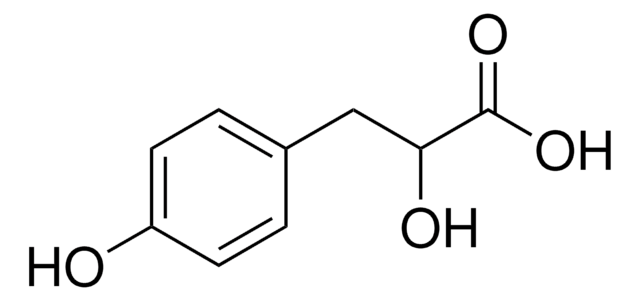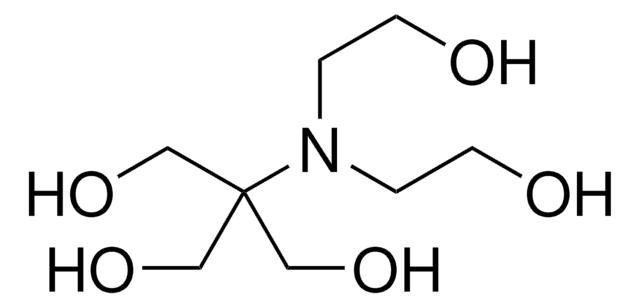H3375
HEPES
≥99.5% (titration)
동의어(들):
4-(2-Hydroxyethyl)piperazine-1-ethanesulfonic acid, N-(2-Hydroxyethyl)piperazine-N′-(2-ethanesulfonic acid)
About This Item
추천 제품
분석
≥99.5% (titration)
양식
crystalline powder
저장 조건
dry at room temperature
기술
cell culture | mammalian: suitable
색상
white
pH
5.0-6.5 (25 °C, 238 g/L)
유용한 pH 범위
6.8-8.2
pKa(25 °C)
7.5
solubility
water: 500 mg/mL, clear, colorless
적합성
suitable for component for culture media
suitable for enzyme extraction
응용 분야
diagnostic assay manufacturing
general analytical
life science and biopharma
pharmaceutical
SMILES string
OCCN1CCN(CC1)CCS(O)(=O)=O
InChI
1S/C8H18N2O4S/c11-7-5-9-1-3-10(4-2-9)6-8-15(12,13)14/h11H,1-8H2,(H,12,13,14)
InChI key
JKMHFZQWWAIEOD-UHFFFAOYSA-N
유사한 제품을 찾으십니까? 방문 제품 비교 안내
일반 설명
Widely utilized in cell culture, HEPES excels at maintaining physiological pH despite fluctuations in carbon dioxide concentration produced by cellular respiration, a feature not as prominent in bicarbonate buffers. It serves as an ampholytic separator for creating pH gradients in isoelectric focusing and exhibits less interference with DNA-restriction enzyme reactions compared to buffers with fewer substituted amine groups, such as Tris. Beyond these applications, HEPES may find application in various biological and biochemical studies, including immunoprecipitation, cell lysis, and live cell imaging. Its versatility makes it an indispensable tool in diverse research applications.
애플리케이션
- As a component in Danieau medium, which is used to prevent melanin pigment formation post gastrulation of zebra-fish embryo
- As a component of Hanks′ solution used in the degradation testing of Iron
- As a component of HEPES medium in the transfection of cell culture with plasmids
- Along with RPMI-1640, L-glutamine, FBS, Sodium pyruvate and β-mercaptoethanol for the culturing of rat insulinoma cells
- As a supplement in TCM199 medium for washing fresh oocytes required for nuclear transfer studies
특징 및 장점
- High purity product for biochemical and biological research
- Suitable for Cell culture
- Highly soluble in water with a useful pH range of 6.8 - 8.2 and pKa of 7.5 at 25 °C
기타 정보
Easily compare specifications for HEPES products with the HEPES specification table.
법적 정보
또한 이 제품과 함께 일반적으로 구입
Storage Class Code
11 - Combustible Solids
WGK
WGK 1
Flash Point (°F)
Not applicable
Flash Point (°C)
Not applicable
개인 보호 장비
Eyeshields, Gloves, type N95 (US)
이미 열람한 고객
문서
rganoid culture products to generate tissue and stem cell derived 3D brain, intestinal, gut, lung and cancer tumor organoid models.
자사의 과학자팀은 생명 과학, 재료 과학, 화학 합성, 크로마토그래피, 분석 및 기타 많은 영역을 포함한 모든 과학 분야에 경험이 있습니다..
고객지원팀으로 연락바랍니다.







